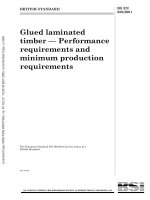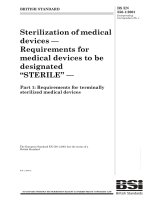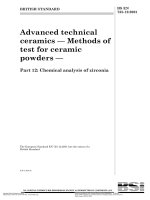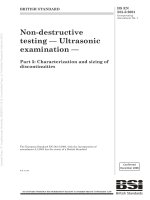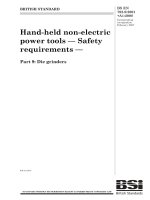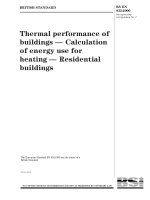Bsi bs en 13150 2001
Bạn đang xem bản rút gọn của tài liệu. Xem và tải ngay bản đầy đủ của tài liệu tại đây (593.02 KB, 22 trang )
BRITISH STANDARD
Workbenches for
laboratories —
Dimensions, safety
requirements and test
methods
The European Standard EN 13150:2001 has the status of a
British Standard
ICS 71.040.10
NO COPYING WITHOUT BSI PERMISSION EXCEPT AS PERMITTED BY COPYRIGHT LAW
BS EN
13150:2001
BS EN 13150:2001
National foreword
This British Standard is the official English language version of
EN 13150:2001. This British Standard partially supersedes BS 3202-2:1991,
which remains current but which will be amended accordingly.
The UK participation in its preparation was entrusted to Technical Committee
LBI/18, Laboratory furniture and fittings, which has the responsibility to:
—
aid enquirers to understand the text;
—
present to the responsible European committee any enquiries on the
interpretation, or proposals for change, and keep the UK interests
informed;
—
monitor related international and European developments and
promulgate them in the UK.
A list of organizations represented on this committee can be obtained on
request to its secretary.
Cross-references
The British Standards which implement international or European
publications referred to in this document may be found in the BSI Standards
Catalogue under the section entitled “International Standards Correspondence
Index”, or by using the “Find” facility of the BSI Standards Electronic
Catalogue.
A British Standard does not purport to include all the necessary provisions of
a contract. Users of British Standards are responsible for their correct
application.
Compliance with a British Standard does not of itself confer immunity
from legal obligations.
This British Standard, having
been prepared under the
direction of the Sector Policy
and Strategy Committee for
Materials and Chemicals, was
published under the authority
of the Standards Policy and
Strategy Committee and comes
into effect on 22 August 2001
Summary of pages
This document comprises a front cover, an inside front cover, the EN title page,
pages 2 to 18, an inside back cover and a back cover.
The BSI copyright date displayed in this document indicates when the
document was last issued.
Amendments issued since publication
Amd. No.
© BSI 22 August 2001
ISBN 0 580 37931 0
Date
Comments
EN 13150
EUROPEAN STANDARD
NORME EUROPÉENNE
EUROPÄISCHE NORM
May 2001
ICS 71.040.10
English version
Workbenches for laboratories - Dimensions, safety requirements
and test methods
Paillasses de laboratoire - Dimensions, spécification de
sécurité et méthodes d'essai
Arbeitstische für Laboratorien - Maße,
Sicherheitsanforderungen und Prüfverfahren
This European Standard was approved by CEN on 16 April 2001.
CEN members are bound to comply with the CEN/CENELEC Internal Regulations which stipulate the conditions for giving this European
Standard the status of a national standard without any alteration. Up-to-date lists and bibliographical references concerning such national
standards may be obtained on application to the Management Centre or to any CEN member.
This European Standard exists in three official versions (English, French, German). A version in any other language made by translation
under the responsibility of a CEN member into its own language and notified to the Management Centre has the same status as the official
versions.
CEN members are the national standards bodies of Austria, Belgium, Czech Republic, Denmark, Finland, France, Germany, Greece,
Iceland, Ireland, Italy, Luxembourg, Netherlands, Norway, Portugal, Spain, Sweden, Switzerland and United Kingdom.
EUROPEAN COMMITTEE FOR STANDARDIZATION
COMITÉ EUROPÉEN DE NORMALISATION
EUROPÄISCHES KOMITEE FÜR NORMUNG
Management Centre: rue de Stassart, 36
© 2001 CEN
All rights of exploitation in any form and by any means reserved
worldwide for CEN national Members.
B-1050 Brussels
Ref. No. EN 13150:2001 E
Page 2
EN 13150:2001
Contents
Page
Foreword . . . . . . . . . . . . . . . . . . . . . . . . . . . . . . .
1 Scope . . . . . . . . . . . . . . . . . . . . . . . . . . . . . . . .
2 Normative references . . . . . . . . . . . . . . . . . . . . .
3 Terms and definitions . . . . . . . . . . . . . . . . . . . . .
4 Recommended dimensions . . . . . . . . . . . . . . . . .
5 General safety requirements . . . . . . . . . . . . . . . .
6 Specific requirements . . . . . . . . . . . . . . . . . . . . .
7 User information . . . . . . . . . . . . . . . . . . . . . . . .
8 Marking and labelling . . . . . . . . . . . . . . . . . . . . .
9 Test report . . . . . . . . . . . . . . . . . . . . . . . . . . . .
Annex A (normative) Test methods for safety testing
Annex B (informative) Optional tests . . . . . . . . . . .
.
.
.
.
.
.
.
.
.
.
.
.
.
.
.
.
.
.
.
.
.
.
.
.
.
.
.
.
.
.
.
.
.
.
.
.
.
.
.
.
.
.
.
.
.
.
.
.
.
.
.
.
.
.
.
.
.
.
.
.
.
.
.
.
.
.
.
.
.
.
.
.
.
.
.
.
.
.
.
.
.
.
.
.
.
.
.
.
.
.
.
.
.
.
.
.
.
.
.
.
.
.
.
.
.
.
.
.
.
.
.
.
.
.
.
.
.
.
.
.
.
.
.
.
.
.
.
.
.
.
.
.
.
.
.
.
.
.
.
.
.
.
.
.
.
.
.
.
.
.
.
.
.
.
.
.
.
.
.
.
.
.
.
.
.
.
.
.
.
.
.
.
.
.
.
.
.
.
.
.
.
.
.
.
.
.
.
.
.
.
.
.
.
.
.
.
.
.
.
.
.
.
.
.
.
.
.
.
.
.
.
.
.
.
.
.
.
.
.
.
.
.
.
.
.
.
.
.
.
.
.
.
.
.
.
.
.
.
.
.
.
.
.
.
.
.
.
.
.
.
.
.
.
.
.
.
.
.
.
.
.
.
.
.
.
.
.
.
.
.
.
.
.
.
.
.
.
.
.
.
.
.
.
.
.
.
.
.
.
.
.
.
.
.
.
.
.
.
.
.
.
.
.
.
.
.
.
.
.
.
.
.
.
.
.
.
.
.
.
.
.
.
.
.
.
.
.
.
.
.
.
.
.
.
.
.
.
.
.
.
.
.
.
.
.
.
.
2
2
3
3
4
6
7
7
8
8
9
12
Foreword
This European Standard has been prepared by Technical Committee CEN/TC 207 "Furniture", the secretariat
of which is held by IBN.
This European Standard shall be given the status of a national standard, either by publication of an identical text
or by endorsement, at the latest by November 2001, and conflicting national standards shall be withdrawn at the
latest by November 2001.
This European Standard EN 13150 is applicable with date of publication (dop.) For workbenches for laboratories
complying with a national standard before dop, this previous national standard may continue to apply for
production and placing on the market until 2 years after dop. This standard does not apply to workbenches for
laboratories, which have been put into service in the laboratory before 2 years after dop.
Annex A is normative. Annex B is informative.
According to the CEN/CENELEC Internal Regulations, the national standards organizations of the following
countries are bound to implement this European Standard: Austria, Belgium, Czech Republic, Denmark, Finland,
France, Germany, Greece, Iceland, Ireland, Italy, Luxembourg, Netherlands, Norway, Portugal, Spain, Sweden,
Switzerland and the United Kingdom.
1 Scope
This European Standard specifies safety requirements and test methods for workbenches for laboratories
including laboratory tables and gives recommendations for their dimensions.
This European Standard applies to workbenches, movable tables and workbench shelves designed for use in
research, educational, quality control and similar laboratories.
This European Standard does not apply to workbenches for pupils in scientific class rooms of schools. It does
not apply to workbenches for special purposes, e.g. for heavy diagnostic or processing machines.
It should be understood that fulfilling the requirements does not ensure that failure will not occur as a result of
habitual misuse or after an excessively long period of service. The tests are designed to be applied to a standalone workbench that is fully assembled and ready for use.
Page 3
EN 13150:2001
Requirements and test methods related to the fire safety of workbenches and to the resistance of the work
surface are not included in this European Standard.
2 Normative references
This European Standard incorporates by dated or undated reference, provisions from other publications. These
normative references are cited at the appropriate places in the text and the publications are listed hereafter. For
dated references, subsequent amendments to or revisions of any of these publications apply to this European
standard only when incorporated in it by amendment or revision. For undated references the latest edition of the
publication referred to applies (including amendments).
EN 527-1:2000, Office furniture - Work tables and desks - Part 1: Dimensions
EN 1730, Domestic furniture - Tables - Test methods for determination of strength, durability and stability
prEN 12600:1999, Glass in building - Pendulum test - Impact test method for flat glass and performance
requirements
EN 61010-1, Safety requirements for electrical equipment for measurement, control and laboratory use - Part
1: General requirements (IEC 61010-1:1990 + A1:1992, modified)
ISO 48, Rubber, vulcanized or thermoplastic – Determination of hardness (hardness between 10 IRHD and 100
IRHD)
ISO 2813, Paints and varnishes - Determination of specular gloss of non-metallic paint films at 20°, 60° and 85°
3 Terms and definitions
For the purposes of this European Standard, the following terms and definitions apply.
3.1
work surface height, h 1
vertical distance between the floor and the top of the work surface (see Figure 1)
3.2
overworkbench shelf height, h 2
vertical distance between the floor and the top of the shelf surface (see Figure 1)
3.3
bottom rail height, h 3
vertical distance between the floor and the lower part of bottom rail (see Figure 2)
3.4
overall depth, d 1
horizontal distance between the front and the rear edge of the workbench including possible service zones (see
Figure 2)
3.5
clear work surface depth, d 2
horizontal distance between the front and the rear edge of the workbench excluding edges and possible service
zones (see Figure 2)
3.6
overworkbench shelf depth, d 3
horizontal distance between the front and the rear edge of the overworkbench shelf (see Figure 2)
3.7
service zone depth, d 4
horizontal distance of overall depth d1 minus clear work surface depth d2 (see Figure 2)
Page 4
EN 13150:2001
3.8
static test
test consisting of heavy loads being applied a few times to ensure that the workbench has sufficient strength to
perform its function under the highest levels of loading that might reasonably be expected to occur
3.9
impact test
test to assess the strength of the workbench under the rapid rates of loading that occasionally occur
3.10
fatigue test
test simulating the repeated application of loads or movement of components occurring during long-term use and
assessing the durability of the workbench under such conditions
3.11
structure
load bearing parts of the workbench including the frame, top and legs
3.12
workbench
work surface with supporting structure and services as required
3.13
movable workbench or table
unit which is not fixed to the floor or wall nor has any service connections
NOTE This definition is for the purpose of the drop test only (see A.3.7).
4 Recommended dimensions
Other dimensions than those recommended in this clause 4 may be agreed between customer and manufacturer.
4.1 Heights
4.1.1 Work surface height
The nominal heights h1 are listed in Table 1. In every case there should be an levelling range of minimum
20 mm. For seated work the relationship between seat height and work surface height is critical. The use of
adjustable height seat is recommended.
Table 1 - Work surface heights
Type of workbench
Sitting
Standing
a)
a)
Nominal heights h1 in mm
720
900
or sitting on high chairs or stools
4.1.2 Leg room
Minimum leg room under the workbench should be in accordance with clause 6 of EN 527-1:2000.
Page 5
EN 13150:2001
4.1.3 Overworkbench shelves
For workbenches with a depth > 600 mm, the maximum height h2 of the highest reagent shelf combined with
the workbench should be 1750 mm (see Figure 1).
4.1.4 Bottom rails
If there are bottom rails, the height h3 (see Figure 2) should be minimum 150 mm.
4.2 Depths
4.2.1 Overall depth
The recommended depths are listed in Table 2.
Table 2 - Depths
Part of workbench
Depth in mm
Clear work surface d2
600 to 900
Service zone d4
50 to 400
Overworkbench shelves d3
max. 150 for reagents; min. 150 for equipment
Overall depth d1
Clear work surface plus possible service zone
NOTE Drawings are examples only.
Figure 1 - Front view of a workbench
Figure 2 - Side view of two
workbenches back-to-back
Page 6
EN 13150:2001
4.2.2 Clear work surface depth
The clear work surface depth d2 should be minimum 600 mm and maximum 900 mm (see Figure 2).
4.2.3 Service zone depth
The depth of the service zone d4 should be minimum 50 mm and maximum 400 mm (see Figure 2).
4.2.4 Depth of overworkbench shelving
The depth of overworkbench shelving d3 should be maximum of 150 mm for reagents and minimum 150 mm for
equipment (see Figure 2).
4.3 Length
The length l1 should be in multiples of 300 mm with prefered dimensions of 600 mm up to 1800 mm (see Figure
1).
5 General safety requirements
Workbenches shall be manufactured so as to minimise injuries and damage to the human body or parts of the
body during normal working conditions. Components or parts of the workbench with which the user may come
into contact during intended use shall not have burrs, sharp edges or sharp corners and points.
Workbenches shall be manufactured from materials which are resistant to the mechancial, chemical and thermal
requirements of the intended use of the workbench. Any vertical glass component greater than or equal to
0,06 m 2 shall comply with prEN 12600:1999 type 4B or 4C.
The width of accessible apertures (excluding drawers and doors and their associated fittings but including the
gap between handles and other parts of the structure) shall always be either less than 8 mm or more than
25 mm. Handles shall not incorporate recesses in which substances may accumulate. Accessible open ends and
feet of tubular components shall be capped or otherwise closed.
Work surfaces specifically designed to retain liquids shall be provided with retaining edges on all sides so that
the retention capacity is min. 5 litres per square metre of work surface.
Any joints and work surfaces shall be made using materials to give a surface which will not crack, retain dirt or
foreign matter or absorbs liquid. When required by the intended use, special care shall be taken to ensure that
the growth of harmful pathogenic agents will not be promoted or sustained.
A retaining strip of min. 30 mm height shall be provided on the rear edges and open ends of overworkbench
shelves unless they abut a wall. When the work requires it, a separation shield shall be provided between two
opposite work surfaces.
6 Specific requirements
6.1 Stability
A free standing workbench shall not overturn when tested in accordance with 6.3.
6.2 Strength and durability
The workbench shall show no failure which can affect safety when tested as specified in 6.3 and it shall still fulfil
its function. Furthermore in the deflection of workbench shelves test (see A.3.4) there shall be no deflection
greater than span/200 under load and no permanent deflection greater than span/1000 24 hours after unloading.
Page 7
EN 13150:2001
6.3 Sequence and conditions of safety testing
The sequence of safety testing and the test conditions shall be as specified in Table 3.
NOTE
A list of optional test methods and suggested requirements is included in annex B.
Table 3 - Conditions for safety testing
Subclause
Test
Parameter
Value
600
A.3.1
Horizontal static load
Force in N
A.3.2
Vertical static load
- main surface
- ancillary surface
Force in N
2000
500
A.3.3
Sustained vertical load if
required
kg/dm 2
1,25
A.3.4
Deflection of workbench
shelves
kg/dm 2
1,25
A.3.5
Horizontal impact stability
Drop height in mm
Mass in kg
40
50
A.3.6
Vertical load stability
- without drawers
- with drawers
A.3.7
Drop
Mass in kg
100
75
Drop height in mm
150
6.4 Surface reflection
The reflection of the work surface shall be stated by the manufacturer and shall be determined in accordance
with ISO 2813 at 60 degrees.
6.5 Electrical safety
All the electrical features shall comply with the relevant requirements given in EN 61010-1.
NOTE
Attention is drawn to relevant national regulations.
7 User information
A manual shall be supplied with workbenches for laboratories which covers at least the following items:
a) description of the main constructional parts;
b) installation instructions, if the workbench is not installed by the manufacturer;
c) operating instructions;
d) safety instructions;
e) maintenance and cleaning instructions;
Page 8
EN 13150:2001
f) spare part list.
8 Marking and labelling
The following inscriptions shall be mounted at each workbench for laboratories at a suitable, visible place:
a) name and/or trade mark of the manufacturer;
b) unambiguous type designation;
c) year or date of production.
The manufacturer may claim the conformance of the workbench with this European Standard by the inscription
"EN 13150".
9 Test Report
The test report shall include at least the following:
(a) the number of this European Standard;
(b) details of the workbench tested;
(c) details of any defects observed before the tests;
(d) details of any defects observed after the tests;
(e) the test result;
(f) details of any deviation from the test procedures.
Page 9
EN 13150:2001
Annex A
(normative)
Test methods for safety testing
A. 1 General test conditions
A. 1.1 Preliminary preparation
The tests shall be carried out in indoor conditions. When temperature is less than 15 °C or more than 25 °C this
shall be recorded in the test report.
Before any of the tests are commenced, the workbench shall be old enough to ensure that it has developed its
full strength. At least four weeks in normal indoor conditions shall have elapsed between manufacture and testing
in the case of glued joints in timber and the like.
A. 1.2 Application of forces
The forces in strength tests shall be applied sufficiently slowly to ensure that dynamic effects are negligible. The
forces in fatigue tests shall be applied sufficiently slowly to ensure that heating does not occur.
A. 1.3 Tolerances
For tolerances, unless otherwise stated all forces shall be measured to an uncertainty of ± 5%, all masses to an
uncertainty of ± 0,5% and all dimensions to an uncertainty of ± 1,0 mm. The measurement of linear deformations
shall have an uncertainty of ± 0,1 mm.
A. 2 Test apparatus
A. 2.1 Horizontal force application device capable of applying a gradually increasing horizontal force to the
workbench at the height of its top. The device shall be capable of applying the force at the required angle of
inclination to the horizontal and shall not hinder any free movement of the workbench.
A. 2.2 Vertical force application device capable of applying either a fixed vertical force, or a gradually
increasing vertical force. The device shall not hinder any free movement of the workbench.
A. 2.3 Horizontal impact device (see Figure A.1), consisting of a basketball inflated to a pressure of (74,5 ±
5) kPa and attached by a network of elastic retaining straps to an annular seating. The ball mounting shall consist
of a ring of timber (or timber derivative) having an outside diameter of 150 mm and an inside diameter of 90 mm.
Its rear face shall be attached to the main body of the impactor and its front face shaped to fit the ball.
The main body of the impactor shall consist of a mass supported by cords or flexible wires 850 mm long so that
the longitudinal axis of the ball, mounting ring and main body assembly shall remain horizontal when the support
cords are displaced from the vertical. The main body of the impactor shall be of such a mass that the total mass
of all moving parts, excluding the support cords shall be 50 kg.
A. 2.4 Floor, horizontal, flat and rigid with a smooth melamine surface. For the drop test (see A.3.7) a rubber
mat 2 mm thick, with hardness (85 + 5) IRHD according to ISO 48, on a concrete floor.
A. 2.5 Stops, to prevent the workbench from sliding but not from overturning. Stops shall not be higher than
12 mm except in cases where the design of the workbench necessitates the use of higher stops, where the
lowest stop that will prevent the workbench from sliding shall be used.
Page 10
EN 13150:2001
A. 2.6 Loading Pad, rigid cylindrical object 100 mm in diameter, with a flat face and a 12 mm edge radius.
A. 2.7 Masses, which do not reinforce the structure of the workbench. If bags with lead shot or the like are used,
the bags shall be divided into small compartments to prevent the contents from moving during the test.
A. 3 Test Procedures
A. 3.1 Horizontal static load test
Restrain the base of the workbench by stops placed at the end at which the test force is first applied.
Apply the force (see A.2.1) as specified in Table 3 by means of the loading pad (see A.2.6) to the edge of the
work surface. Begin loading with the force horizontal. If the workbench tends to overturn, incline the force
downwards gradually until the workbench is just prevented from overturning (see Figure A.3).
Apply the force ten times at point A (see Figure A.2) first along the longitudinal centreline and then remove it and
reapply it ten times at point B in the opposite direction. Leave the stops in position for the reversal of the
application of the test force.
Repeat the above loading along the transverse centreline of the top in two directions at points C and D (see
Figure A.2).
NOTE
More details of the test procedure are given in EN 1730.
A. 3.2 Vertical static load test
Apply a vertical downward force (see A.2.2) as specified in Table 3 to the work surface of the workbench. Apply
the force 10 times using the loading pad (see A.2.6) anywhere on the work surface likely to cause a failure but
not less than 100 mm from any edge. If there are several such positions repeat the test (see Figure A.4) at those
positions.
Repeat the test on each ancillary work surface e.g. flaps or leaves, using the force specified in Table 3. If the
workbench tends to overturn, load the main work surface sufficiently to prevent overturning.
A. 3.3 Sustained vertical load test
The test is only carried out if the vertical static load test shows deflection of the work surface affecting the safety
of the workbench.
NOTE The aim of the sustained vertical load test is to check that any deflection developed due to longterm loading of the
horizontal surfaces remains within limits which are acceptable in respect of safety.
Load the work surface with an uniformly distributed load as specified in Table 3 and leave it loaded for 24 hours.
The following measurements shall be made:
a) deviation from straight before loading;
b) deflection after 24h when loaded;
c) deflection after 24h after unloading.
Page 11
EN 13150:2001
A. 3.4 Deflection of workbench shelves
Load the shelf with a uniformly distributed load as specified in Table 3 and leave it loaded for 24 hours. Measure
the deflection of the shelf at the middle as close as possible to the front edge. If the shelf has one or more
supports, the deflection shall be measured where it is greatest.
The following measurements shall be made:
a) deviation from straight before loading;
b) deflection after 24 hours when loaded;
c) deflection after 24 hours after unloading.
The deflections from a straight line and the distance between supports shall be reported in millimetres as
difference b) - a) respectively c) - a).
A. 3.5 Horizontal impact stability test of free standing workbenches
Position the workbench on the floor with the stops against the legs furthest from the position of impact. Impact
the workbench using the horizontal impactor (see A.2.3) falling through the height specified in Table 3, so that
the impactor strikes the top edge of the workbench at the position likely to have the most adverse effect.
A. 3.6 Vertical load stability test of free standing workbenches
Apply, by means of the loading pad (see A.2.6), a vertical load of 1000 N (see Table 3) at any point on that side
which may produce the most adverse result. The centre of gravity of the load shall be 50 mm from the outer edge
of the workbench top (see Figure A.5).
Repeat the test on one short side of the workbench and with the vertical force at the centre of this short side.
Repeat the above procedure on the other long side and then on the other short side of the workbench if it is
constructed differently (i.e. if the workbench is not symmetrical).
If the workbench is equipped with drawers fixed to the structure, load the drawers with the load of 0,5 kg/dm3.
Open the drawers in the most adverse combination. For example, when an interlock is not fitted all drawers shall
be opened but when an interlock is fitted only the largest drawer in each pedestal shall be opened. The drawers
shall be opened as far as the open stop will allow and a vertical load of 750 N shall be applied at the centre of
the front of the workbench 50 mm from the edge (see Figure A.5).
Record if the workbench overbalances.
A. 3.7 Drop test of movable workbenches (tables)
This test refers to movable workbenches or tables. Lift the workbench at one end (see Figure A.6) and then allow
it to fall freely from the height specified in Table 3 so that the impacting feet or castors strike the floor (see A.2.4).
Carry out the test 10 times.
Repeat the test on the other end of the workbench if it is constructed differently (i.e. if the workbench is not
symmetrical).
Page 12
EN 13150:2001
Annex B
(informative)
Optional tests
B.1 General
The optional test methods specified in the annex B together with the loads and cycles recommended in Table
B.1 can be used for the assessment of strength and durability of workbenches for laboratories.
Table B.1 - Conditions for non-safety testing of workbenches
Clause
Test
Parameter
Values
B.3
Horizontal fatigue
Force in N
n° of cycles
150/200/250/300
5000/10000/15000/20000
B.4
Vertical fatigue
Force in N
n° of cycles
300/400/500
5000/10000/15000/20000
B.5
Vertical impact
Drop height in mm
150/200/300
B.2 Vertical impactor (see Figure B.1)
B.2.1 Cylindrical body, approximately 200 mm in diameter, separated from the striking surface by helical
compression springs and free to move relative to it on a line perpendicular to the plane of the central area of the
striking surface. The body and associated parts minus the springs shall have a mass of (17 ± 0,1) kg and the
whole apparatus, including body, springs and striking surface, shall have a mass of (25 ± 0,1) kg.
B.2.2 Springs, such that the combined spring system has a nominal spring rate of (6,9 ± 1) N/mm and the total
frictional resistance of the moving parts shall be between 0,25 N and 0,45 N. The spring system shall be
compressed to an initial load of (1040 ± 5) N (measured statically) and the amount of spring compression
movement available from the initial compression point to point where the springs become fully closed shall not
be less than 60 mm.
B.2.3 Striking surface, shall be a rigid circular object, 200 mm in diameter, the face of which has a convex
spherical curvature of 300 mm radius with a 12 mm front edge radius.
B.3 Horizontal fatigue test
Restrain the base of the workbench with stops in all directions and at all legs. Place a mass of 50 kg on the
geometric centre of the workbench top.
Apply a horizontal force (see A.2.1) of the selected magnitude as specified in Table B.1 alternatively at point a
and b, as shown in Figure B.2, by means of two loading pads (see A.2.6). Apply the force for the selected
number of cycles (see Table B.1). Repeat the test at the other corner positions c and d (see Figure B.2).
If the workbench tends to overturn in one direction using the force selected, reduce the horizontal force to the
highest value that does not cause overturning. Perform the test using this reduced force in that direction only.
Record the value of any reduced force used.
Page 13
EN 13150:2001
B.4 Vertical fatigue test
Apply the selected vertical downward force (see Table B.1) to the top at the most adverse position 100 mm from
the top edge of the workbench, the loading pad centre being at 100 mm from the workbench top edge. Maintain
the force for at least 2 seconds. Remove it for at least 2 seconds before the next application. Carry out the
number of selected cycles as given in Table B.1.
B.5 Vertical impact test
Allow the vertical impactor (see B.2.1) to fall freely from the selected height (see Table B.1) onto the work surface
at the following positions:
- 10 times as close as possible to one point of support of the work surface but not less than 100 mm
from any edge;
- 10 times 100 mm from the edge at the centre of the longest span;
- 10 times 100 mm from the edges at one corner.
NOTE For different geometries, the "centre of the edge of the longest span" is a point 100 mm from the edge of the work
surface as far away from the supports as possible.
Page 14
EN 13150:2001
All dimensions in millimetres
Key
1 Safety clamp
2 Mass
3 Further masses
4 Timber ball mounting ring
5 Basket ball
6 Elastic retaining straps
Figure A.1 - Horizontal impact device
Page 15
EN 13150:2001
Figure A.2 - Positions of forces and stops during horizontal static load test
Figure A.3 - Inclination of force during horizontal static load test
Page 16
EN 13150:2001
Key
1 Span
2 Force
d Declination
Figure A.4 - Vertical static load test
Page 17
EN 13150:2001
Figure A.5 - Vertical load stability test
Key
1 Drop height
Figure A.6 - Drop test
Page 18
EN 13150:2001
Key
1 Joint of lifting device not inhibiting free fall
Figure B.1 - Details of vertical impactor
Dimensions in millimetres
Figure B.2 - Horizontal fatigue test

